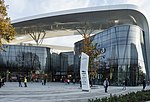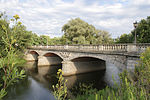Breslau-Dürrgoy concentration camp

Breslau-Dürrgoy concentration camp or KZ Dürrgoy was a short-lived Nazi German concentration camp set up in the southern part of Wrocław (German: Breslau), then in Germany, before World War II on the grounds of the old fertilizer factory "Silesia". It was located in what, since 1945, has become known as the Tarnogaj neighbourhood of Wrocław (German: Dürrgoy), at the Strehlener Chaussee or Strzeliński Street (today ul. Bardzka), opposite the cemetery of the Holy Ghost. The camp, intended for the opponents of Nazism, was established at a place of the former POW camp for French prisoners of World War I, converted and utilized by the fertilizer factory. The new camp was founded on the initiative of the commander of SA in Silesia, SA-Obergruppenführer Edmund Heines, on 12 March 1933, and liquidated on 10 August 1933 with all prisoners transported to a larger concentration camp at Osnabrück.
Excerpt from the Wikipedia article Breslau-Dürrgoy concentration camp (License: CC BY-SA 3.0, Authors, Images).Breslau-Dürrgoy concentration camp
Geographical coordinates (GPS) Nearby PlacesShow on map
Geographical coordinates (GPS)
| Latitude | Longitude |
|---|---|
| N 51.0731 ° | E 17.0508 ° |










